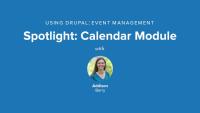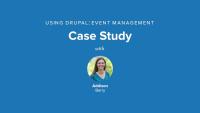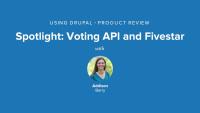We have our Upcoming Events block, but now we need to build out our full calendar. Although this is potentially a daunting task, involving many tables and many variations for the display (week, month, etc.), the Calendar module conveniently comes with a default view that handles most of the difficult bits for us. In this lesson we'll clone the Calendar default view to give us a good starting place, and alter the view to suit our needs.
Additional resources
Although a simple list of upcoming events is very useful, our site has additional requirements for the display of the event data. As is extremely common for event management websites, this site needs an interactive calendar for browsing through past and future events. We need a classic monthly calendar view, along with a day and week views so people can see the calendar in the format they are used to seeing. We also want people to be able to download the calendar and use it in other calendar applications if they'd like. We're going to implement this feature using the Calendar module in conjunction with Views. In this lesson we'll get an overview of how the Calendar module can help us by taking a look at the Calendar View Type, along with the handy built-in iCal Integration.
Additional resources
Drupal 8 Survey Insights
Blog postLast month we asked the Drupal community a few questions. We received 243 responses to our survey, and we'd like to share some of the information. While we're not making scientific generalizations from this data, it is an interesting picture of our community nonetheless. A big thank you to everyone who participated in the survey.
Here are 4 things we learned:
Drupal 8 External Libraries Galore!
Blog postThere are lots of goodies coming in Drupal 8. A lot of work has gone into bring Drupal up to modern web standards. In addition to digging into Drupal-specific problems, a lot of work has gone into removing some of the custom overhead we have by incorporating a number of external libraries—that is, code that other communities have created and maintain, and does not live on Drupal.org. Adding external libraries means that we are working with these other open source communities to maintain our code, and that lets us focus on the Drupalisms we need, instead of re-inventing the wheel all over the place. This is the biggest growth for exernal libraries that we've ever seen, and I decided to take a look at what we have in core now.
To get things started we need to create a new, basic content type just for events. We just need the event name and description along with an easy way to add the event location. In this lesson, we'll create the content type and set up our permissions.
Additional resources
Now that we have our basic Event content type set up, we'll enhance it by adding a date field, so that members may schedule meetings. In this lesson, we'll add and configure our new date field, and then create a new event to test it all out.
Additional resources
To kick off this series, we're going to take a look at the needs for our project. Our client is the Aurora Book Club, and they need a way to track events along with who is attending the events. In this lesson, we'll discuss the requirements, and how we'll implement them. We'll also be taking a tour of the finished site so we can see where we're headed. At the end of this lesson you should understand what the target site is that we will be building.
Additional resources
The main building block for the site is our new Event content type. The information that we need it to provide us with is “where” and “when.” We have taken care of the “where” part in our initial setup, and the Date module helps us answer the “when” question, in an incredibly flexible manner. Our main interest in the Date module is the ability to add a field to our Event content type to indicate date and time. However, looking at the Date module more closely, there are a few extra pieces worth noting. In this lesson we'll get a good overview of what the Date module provides by looking at Submodules, Field Types, Form Elements, and Field Settings.
Additional resources
Case studies can provide a much needed context when learning a new concept or technology. Each learning series based on the book Using Drupal, 2nd edition outlines a case study that our trainer, Addison Berry, uses to provide something akin to client requirements for a Drupal 7 site build. Our latest series, Using Drupal Chapter 6: Event Management, features a local book club that wants to provide an events calendar and list of upcoming events on their Drupal 7 website.
In these five lessons wrapping up Chapter 5: Product Reviews, Addison Berry covers how to make your product reviews findable with Drupal's Search module as well as exposed filters in Views.
Drupal’s built-in Search module offers powerful, flexible searching features and intelligent ranking of results. Behind the scenes, it’s silently building an index of all the words used in the site’s content. In this lesson we'll:
- Review the Search module settings
- Explain the importance of cron
- Discuss searching with Views
Additional resources
We’re almost done! The only problem with our view now is that clicking the titles in the view links to Amazon.com instead of to our own website. Fortunately, Views provides a handy trick for just this sort of situation; we can “rewrite” the output of the Title field to create a link back to its referring node instead. In this lesson, we'll:
- Exclude a field from display
- Rewrite the output of a field
Additional resources
You've built the site that Bob and Sarah need to get their reviews going, but as always, there are ways to add more neat features. In this lesson, we'll look at a few modules you can look at adding down the road
- AdSense
- Display Suite
- Blog (core)
- Recipe
Additional resources
We’ve hit all of the major pieces of functionality that Bob and Sarah wanted. In this summary, we'll:
- Tour the Super Duper Chefs site
- Discuss our implementation points
- Review modules and resources
Additional resources
I thought that for my newest blog post I would try something different, and something I have been asked to do in the past, a video tutorial of a Drupal 8 inspired illustration.
Drupalize.Me Podcast Episode 43
Blog postIn this week's episode, 43: Web Services, Addison Berry along with Lullabots Sally Young and Joe Shindelar discuss the Services module for Drupal.
This week, we've got five shiny new videos in Addison Berry's series, Using Drupal Chapter 5: Product Reviews. If you've been following along, in this series we're building a website containing product reviews using Drupal 7. So far, we've reviewed the case study and site requirements and added the Amazon module so we can integrate data from amazon.com into our Drupal site. Now it's time to add ratings using the Voting API and Fivestar modules and add simple yet useful style to our product reviews using the CSS Injector module, a CSS styling tool for site builders. If you're new to building sites in Drupal 7, this, along with rest of the Using Drupal video collection are a great way to jumpstart your way to becoming a Drupal site building rockstar.
For the Super Duper Chefs site, we’ll be using both of the Fivestar module’s unique features: adding a static Rating field to the “Product review” content type for the editors to use, and attaching a voting widget to the comment form on each review for the site readers to use. That approach will keep the official rating on each review separate from the reader ratings. In this lesson we'll:
- Add the Product Rating Field
- Add the Reader Rating Field
Additional resources
Giving visitors a chance to evaluate and rate content is an extremely common pattern on content-rich websites. In addition to giving visitors a way to jump to the best content, it can give you a way to determine what content on your site is most effective. In this lesson we'll discuss:
- Voting API module
- Fivestar module











